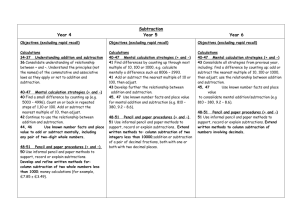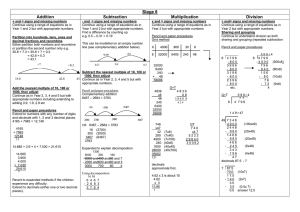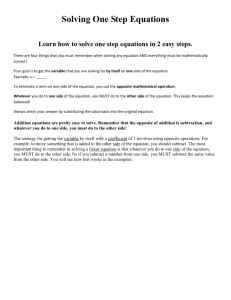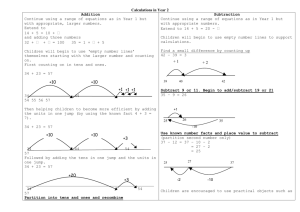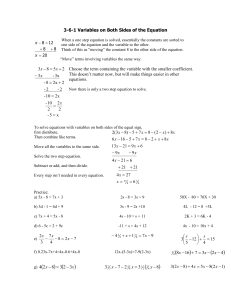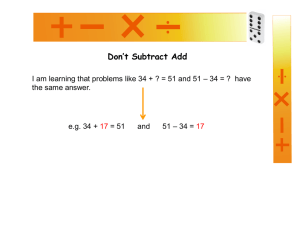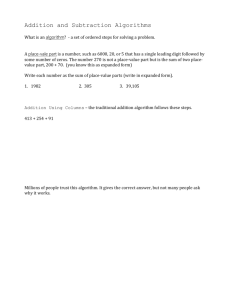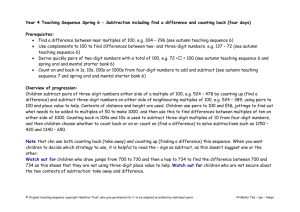subtractionguidelines
advertisement
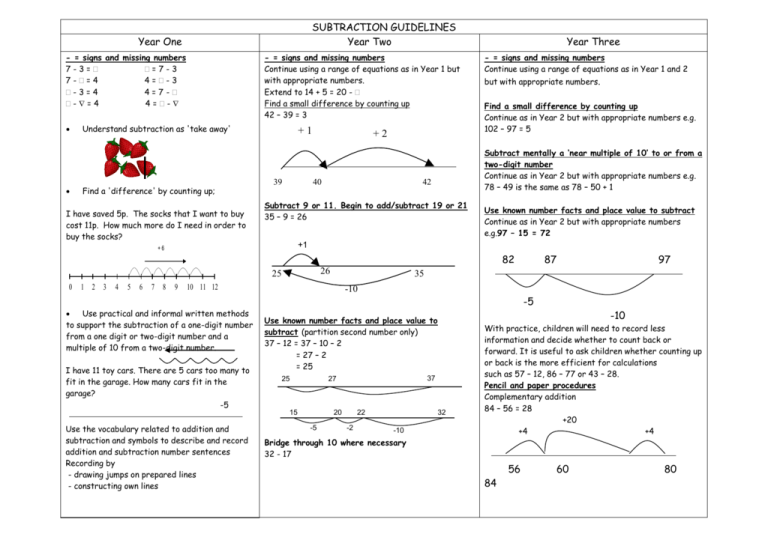
SUBTRACTION GUIDELINES Year Two Year One - = signs and missing numbers 7-3= =7-3 7-=4 4=-3 -3=4 4=7- -=4 4=- - = signs and missing numbers Continue using a range of equations as in Year 1 but with appropriate numbers. Extend to 14 + 5 = 20 - Find a small difference by counting up 42 – 39 = 3 Understand subtraction as 'take away' Find a 'difference' by counting up; I have saved 5p. The socks that I want to buy cost 11p. How much more do I need in order to buy the socks? +1 39 +2 40 Year Three - = signs and missing numbers Continue using a range of equations as in Year 1 and 2 but with appropriate numbers. Find a small difference by counting up Continue as in Year 2 but with appropriate numbers e.g. 102 – 97 = 5 Subtract mentally a ‘near multiple of 10’ to or from a two-digit number Continue as in Year 2 but with appropriate numbers e.g. 78 – 49 is the same as 78 – 50 + 1 42 Subtract 9 or 11. Begin to add/subtract 19 or 21 35 – 9 = 26 Use known number facts and place value to subtract Continue as in Year 2 but with appropriate numbers e.g.97 – 15 = 72 +1 +6 82 26 25 0 1 2 3 4 5 6 7 8 9 10 11 12 Use practical and informal written methods to support the subtraction of a one-digit number from a one digit or two-digit number and a multiple of 10 from a two-digit number. I have 11 toy cars. There are 5 cars too many to fit in the garage. How many cars fit in the garage? -5 Use the vocabulary related to addition and subtraction and symbols to describe and record addition and subtraction number sentences Recording by - drawing jumps on prepared lines - constructing own lines 87 97 35 -10 -5 Use known number facts and place value to subtract (partition second number only) 37 – 12 = 37 – 10 – 2 = 27 – 2 = 25 25 37 27 15 20 -5 22 -2 32 -10 Bridge through 10 where necessary 32 - 17 -10 With practice, children will need to record less information and decide whether to count back or forward. It is useful to ask children whether counting up or back is the more efficient for calculations such as 57 – 12, 86 – 77 or 43 – 28. Pencil and paper procedures Complementary addition 84 – 56 = 28 +20 +4 +4 84 56 60 80 Year Four Year Five Find a small difference by counting up e.g. 5003 – 4996 = 7 This can be modelled on an empty number line (see complementary addition below). Children should be encouraged to use known number facts to reduce the number of steps. Subtract the nearest multiple of 10, then adjust. Continue as in Year 2 and 3 but with appropriate numbers. Use known number facts and place value to subtract 92 – 25 = 67 72 67 Find a difference by counting up e.g. 8006 – 2993 = 5013 This can be modelled on an empty number line (see complementary addition below). Subtract the nearest multiple of 10 or 100, then adjust. Continue as in Year 2, 3 and 4 but with appropriate numbers. Use known number facts and place value to subtract 6.1 – 2.4 = 3.7 4.1 3.7 6.1 92 -5 -20 700 14 (100) 600 (700) 54 (754) 668 Complementary addition 6467 – 2684 = 3783 +54 +16 300 700 OR 2684 +3467 +300 754 754 For those children with a secure mental image of the number line they could record the jumps only: 754 – 86 = 668 Pencil and paper procedures +400 +14 0.5 -0.3 -0.01 +54 286 100 0.2 -2 Complementary addition 754 – 286 = 468 Complementary addition 754 – 86 = 668 86 0.5 – 0.31 = 0.19 Pencil and paper procedures Pencil and paper procedures +600 Find a difference by counting up e.g. 8000 – 2785 = 5215 To make this method more efficient, the number of steps should be reduced to a minimum through children knowing: Complements to 1, involving decimals to two decimal places ( 0.16 + 0.84) Complements to 10, 100 and 100 Subtract the nearest multiple of 10, 100 or 1000, then adjust Continue as in Year 2, 3, 4 and 5 but with appropriate numbers. Use known number facts and place value to subtract 0.19 -0.4 +14 Year Six 2700 3000 6467 OR 754 - 286 = 468 6467 – 2684 = 3783 14 (300) can be refined to 14 (300) 400 (700) 454 (754) 54 (754) 468 468 Reduce the number of steps to make the calculation more efficient. Extend to 2 places of decimals 16 (2700) can be refined to 316 (3000) 300 (3000) 3467 (6467) 3467 (6467) 3783 3783 Reduce the number of steps to make the calculation more efficient. Extend to 2 places of decimals

